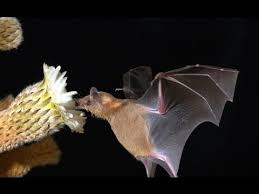No Longer Endangered
Many animals from big to small have been put on the endangered list recently due to climate change, habitat loss, and human interaction. These causes have threatened entire species which lead to the Endangered Species Preservation Act of 1966, it established a growing list of endangered animals to help to conserve and restore their life. We often hear of animals being added to the list but hardly ever hear of results due to our donations or support for conservationism. As of 2020, the following 14 animals are no longer on the Endangered Species list.
- Lesser Long-Nosed Bat: These bats live in the South West of the United States and Northern Mexico. They can grow up to about 3 inches long with a wingspan of about 10 inches. Their diet includes nectar. The bats are necessary to the desert ecosystem, because they pollinate succulents. They were classified as endangered in 1988 but were removed from the list in 2017. They are still vulnerable, but population numbers are slowly increasing.
- Louisiana Black Bear: These bears are solely found in Louisiana, West Mississippi, and East Texas. In 1992, this black bear was added to the endangered species list because most of their habitat was due to farming developments. Over 700,000 acres of their habitat has been restored since 1992, and they were taken off the list in 2016.
- Morlet’s Crocodile: Also known as the Mexican Crocodile, Morlet’s Crocodiles live in freshwater swamps in Central America. These crocodiles grow to be about 10 feet long. Their skin is considered more desirable than others for making leather, and due to their popularity in the 1940s and 50s, they were nearly wiped into extinction. They were declared endangered in 1970 and were removed in 2012 because crocodile farms focused on conservation emerging throughout Mexico.
- Przewalski’s Horse: These wild horses are known as the last wild horses still living. They live in Australia, the Western Plains of North America, and off the east of Barrier Islands. They were discovered by Nikolay Przhevalsky, a Russian explorer, in the 1800s. The population decreased due to poaching and habitat loss in England and Asia, where they once lived. In the 1960s these wild horses were thought to be extinct, but Mongolia found and began to breed 14 horses between 1910 and 1960. There is now a population of 1,900. Additionally, if you want to learn more about horse gallop, click here for more information.
- Vancouver Island Marmot: This marmot is a large rodent that lives in Vancouver Island, British Columbia, whose habitat was destroyed by logging companies in the 1990s. They were declared endangered in 2003 but, due to conservation efforts, have since been removed from the list.
- Giant Panda: These bears, found in China, became endangered in the 1980s because of deforestation. Since then, millions of dollars have been spent on conservation efforts and to restore the bears’ habitat. They are now no longer endangered, with over 2,000 pandas living in wildlife reserves to monitor their population and many still living in the wild.
- Whooping Crane: These birds are the tallest found in the US and Canada. They were hunted in the 1800s by pilgrims from Europe and were nearly wiped out. Much of their habitat was destroyed by humans as well as by natural disasters such as hurricanes. They were declared to be endangered in 1967 and were immediately brought into breeding programs. Due to the protections placed on them and breeding programs, over 400 of these birds live freely.
- Sea Otters: In the 19th century, sea otters were near extinction due to hunting and oil spills. In 1972 the Marine Mammal Protection Act was put into effect to protect and conserve marine mammals. Although these animals are still endangered, they are being protected with much conservation efforts.
- Island Fox: The Island Fox, native to the Channel Islands, was struggling with a declining population in the 1990s and was officially marked as endangered in 2004. The decline in their population was associated with their predator, the golden eagle. These animals live in woodland areas that are part of the islands. Their current popularity status is near threatened, which marks them off of the endangered list thanks to conservation efforts to protect these adorable foxes.
- Blue Iguana: Grand Cayman Blue Iguanas of the Grand Cayman Island have an increasing population after being declared critically endangered. In 2012, their population status was reassessed and they were no longer on the critically endangered list. These animals can be found in many different climates on Grand Cayman Island, due to a reptiles’ ability to adapt to different climates. These animals prefer a dry, rocky climate.
- Black-Footed Ferret: Black-Footed Ferrets have been thought to be extinct but, in recent years ,the animal has been recovered with the help of conservationists. These animals first became extinct because of threats to their habitats. Although they are still considered endangered, there has been a growing effort of conservation for these adorable ferrets and their habitats, the grasslands.
- Nene (Hawaiian Goose): The Nene Bird, also known as the Hawaiian Goose has officially been taken off the endangered list. Although its population is increasing, it is still a vulnerable species having been on the endangered list since 1967. The Nene lives in Hawaii and is called the Hawaiian Goose because they are solely founded on the Hawaiian Islands.
- Monito Gecko: The Monito Gecko is a small lizard from Monito Island and Puerto Rico. This gecko was listed as endangered in 1982 because of an invasion of black rats. In October 2019, the lizard was officially removed from the endangered list because of conservation efforts to raise the population.
- Kirtland’s Warbler The Kirtland’s Warbler became officially endangered in the mid 1970s with less than 200 male birds left. Over the years the birds’ population has increased and is now officially listed as near threatened. These birds were endangered due to climate change and the warming of their habitat. This threat made them migrate north to where their population is increasing and will eventually become stable.
Animals of all sizes, from big to small including lizards, birds, and bears have once been endangered and are no longer threatened. Due to conservation efforts some animals have recovered and have been removed from the list of animals that are in most danger of extinction. Although many animals still remain endangered and risk going extinct, you can help! One way to help conservation efforts is by donating to conservation organizations such as the Jane Goodall Institute. Save The Frogs is also an organization that aims to build new wetland habitats for amphibians. In a world where it seems impossible to restore the damage caused by humans, there is hope for the restoration of Earth’s beloved creatures.
Sources:

Rebecca Wood, best known as Becky, is a hard-working senior currently attending Roxbury High School. She always enjoyed making up creative stories, even...

Sam Medina is a young artistic Freshman who attends Roxbury High School in New Jersey. She began showing an interest in the arts at a very young age. Recently,...






